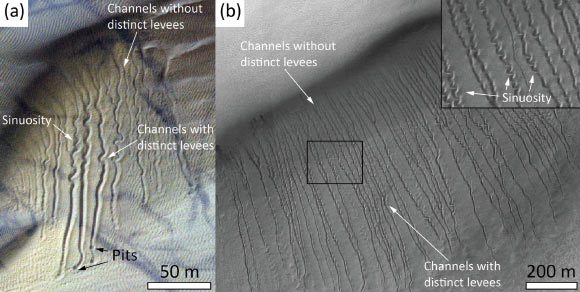On some of the dune fields on Mars, parallel channels, called linear dune gullies, are found. Contrary to their name these gullies are often highly sinuous. In the past, it was believed that these features were formed by debris flow processes driven by liquid water. However, new evidence from satellite images shows that they are active in local spring by a process driven by carbon dioxide ice. The ice forms on the Martian dunes in local winter and breaks off at the top of the dune at the beginning of spring. With new lab experiments in a Mars chamber, planetary scientists from Utrecht University, Le Mans Université, Nantes Université, Institut de Planétologie et d’Astrophysique de Grenoble and the Open University show that linear dune gullies are being formed by blocks of carbon dioxide-ice that slide or burrow themselves into the sandy slope of the dune and move themselves downslope by violently ejecting the surrounding sand. This excavation process is caused by powerful gas flows, created by the sublimation of the carbon dioxide-ice, when the ice is turned into carbon dioxide gas. While sliding blocks of carbon dioxide ice explain the formation of shallow channels, burrowing carbon dioxide-ice explains the creation of the deep, and sinuous channels on the dunes of Mars.

Two examples of Martian dunes with linear dune gullies: (a) linear dune gullies on a dune field in Galle crater; (b) linear dune gullies on a dune field in an unnamed crater in the center of Hellas Planitia. Image credit: Roelofs et al., doi: 10.1029/2024GL112860.
Linear dune gullies are unique and enigmatic landforms that are found on dune fields in the mid-latitudes on planet Mars.
These parallel, and contrary to their name, often sinuous channels, with sharp bends, restricted source areas, distinct levees, and pit-shaped channel endings, do not have an Earth analog.
They are distinct from the classical gully landforms that are observed on steep slopes on Mars and Earth, which are composed of an erosional alcove, channel, and depositional apron, and are often larger than linear dune gullies.
“In our simulation, we saw how high gas pressure blasts away the sand around the block in all directions,” said Utrecht University researcher Lonneke Roelofs, lead author of the study.
“As a result, the block digs itself into the slope and becomes trapped in a hollow surrounded by small ridges of settled sand.”
“However, the sublimation process continues, and so the sand keeps on being blasted in all directions.”
“Due to this process, the block gradually moves downwards, leaving a long, deep gully with small sand ridges on either side behind it.”
“This is exactly the type of gully that is also found on the Red Planet.”
In their research, Dr. Roelofs and co-authors combined laboratory experiments in which they released carbon dioxide-ice blocks on sandy slopes under Martian atmospheric pressure with observations of linear dune gullies on Russell crater mega dune.
“We tried out various things by simulating a dune slope at different angles of steepness,”
“We let a block of carbon dioxide ice fall from the top of the slope and observed what happened.”
“After finding the right slope, we finally saw results. The carbon dioxide ice block began to dig into the slope and move downwards just like a burrowing mole or the sandworms from Dune. It looked very strange.”
“But how exactly do these blocks of ice form? The carbon dioxide ice blocks form on the desert dunes halfway down the southern hemisphere of Mars.”
“During the winter, a layer of carbon dioxide ice forms over the entire surface of the dune field, sometimes up to a thickness of 70 cm! In spring, this ice begins to warm up and sublimate.”
“The last remnants of this ice are located on the shaded side of the dune tops, and that is where the blocks break off from once the temperature is high enough.”
“Once the blocks reach the bottom of the slope and stop moving, the ice continues to sublimate until all the carbon dioxide has evaporated. What remains is a hollow in the sand at the bottom of the dune.”
The study was published October 8 in the journal Geophysical Research Letters.
_____
Lonneke Roelofs et al. 2025. Sliding and Burrowing Blocks of CO2 Create Sinuous ‘Linear Dune Gullies’ on Martian Dunes by Explosive Sublimation-Induced Particle Transport. Geophysical Research Letters 52 (19): e2024GL112860; doi: 10.1029/2024GL112860







